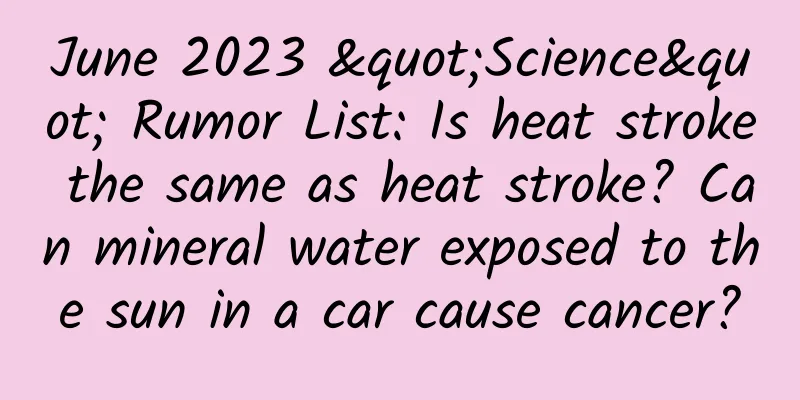June 2023 "Science" Rumor List: Is heat stroke the same as heat stroke? Can mineral water exposed to the sun in a car cause cancer?

|
The list of "scientific" rumors for June 2023 is revealed! Is heat stroke the same as heat stroke? Are the deformities of the cherry "twins" caused by pesticides? Can eye drops relieve dry eyes? The truth >> The monthly "science" rumor list is guided by the Beijing Association for Science and Technology, the Beijing Municipal Cyberspace Administration, and the Capital Internet Association, and jointly released by the Beijing Science and Technology Journalists and Editors Association and the Beijing Regional Website Joint Rumor-Refuting Platform, and is supported by the Science and Technology Journalists and Editors Professional Committee of the China Science Writers Association, the China Evening News Science Editors and Journalists Association, the Shanghai Science Communication Association, and the Institute of Science and Technology Information of the Beijing Academy of Science and Technology. 1. Is heat stroke the same as heat stroke? Myth: Heat stroke is just heat stroke and is not serious. The truth: Heat stroke is not exactly the same as heat stroke, and should not be taken lightly. Generally, the body temperature of heat stroke patients often exceeds 38 degrees Celsius, accompanied by facial flushing, heavy sweating, burning skin, nausea and vomiting, or cold limbs, pale face, low blood pressure, and rapid pulse. Heatstroke is the most serious of heat-related emergencies, also known as "severe heatstroke". It is caused by an imbalance in the body's regulatory functions due to exposure to high temperature and high humidity environments, with heat production exceeding heat dissipation, resulting in a rapid increase in core temperature to over 40°C, accompanied by burning skin, impaired consciousness (such as delirium, convulsions, coma) and multiple organ dysfunction. It is a serious and fatal disease. It is the most serious type of heatstroke. Once it occurs, the mortality rate is extremely high. Heat stroke does not occur suddenly. Before heat stroke develops into heat stroke, one will first experience "pre-heat stroke" and "mild heat stroke". To prevent heat stroke, the first thing to do is to avoid heat stroke. Try to avoid staying in high temperature (high humidity) and unventilated environments. When traveling, avoid high temperatures and take good sun protection. In addition, you can prepare some heatstroke prevention medicines appropriately. When you have to work or do activities outdoors, pay attention to your personal physical condition, drink plenty of water, and rest in time. If you are driving, do not leave children and pets in the car. Be careful to avoid dehydration and ensure adequate sleep. 2. Sun protection clothing cannot be washed. Will it no longer protect against the sun once washed? Rumor: Sun protection clothing will lose its sun protection effect once it is washed. (Photo source: Visual China) The truth: Over-washing sun-proof clothing will indeed reduce the UV protection performance of the clothing, but normal washing is fine. Sun-proof clothing enhances the clothing's UV resistance by adding UV absorbers and UV inhibitors to the fabric, or adding a sunscreen coating to the fabric surface, just like applying a large amount of sunscreen on the surface of the clothing. Professional sun protection clothing generally has a sun protection index on the tag. This index is the result of a national professional organization's standard test. Only when UPF>40 and T (UVA) <5%, it is qualified to be called a "UV protection product" and can be called a "sun protection clothing". Under normal circumstances, if the number of washing times for sun protection clothing is less than 30 times, the sun protection effect will not be significantly reduced. After more than 30 times, it depends on the water resistance of the anti-ultraviolet agent and the processing level of the sun protection clothing. There are two main processes for adding ultraviolet shielding agents to clothes: one is to add it to the spinning raw materials, and the other is to soak or coat the fabric. Generally speaking, the ultraviolet shielding agent added during spinning can better combine with the raw materials, and the anti-ultraviolet performance is still considerable after multiple washings; while the ultraviolet shielding agent attached to the fabric after it is woven into cloth is more likely to be peeled off during washing. The service life of sun protection clothing is generally a few months to a year, and the sunscreen ingredients may be damaged to varying degrees, and the sunscreen effect is definitely worse than when it was first bought. Replacing your sun-protective clothing every year can ensure good sun protection. 3. Will mineral water exposed to the sun in a car cause cancer? Rumor: In summer, mineral water left in the car exposed to the sun can cause cancer. (Photo source: Visual China) The truth: Qualified mineral water bottles on the market are usually made of food-grade plastic, namely polyethylene terephthalate (PET). PET is not only resistant to acid, alkali, and grease, but can also withstand corrosion from most solvents. In an environment below 120°C, PET is non-toxic and odorless, and is safe for beverages. However, when exposed to high temperatures, it will slowly dissolve and release some organic solvents that are harmful to human health. The temperature in a vehicle is generally difficult to reach 120 degrees Celsius even in summer, so the statement that "mineral water exposed to the sun in a car can cause cancer" has no scientific basis. 4. Astronauts cannot be nearsighted because they cannot wear glasses in space? Rumor: Astronauts cannot be nearsighted and cannot wear glasses because wearing glasses in space may cause accidental injuries. ▲Astronaut Gui Haichao (Photo source: Visual China) The truth: The selection criteria for astronauts are indeed very high. However, people with mild myopia are currently allowed to enter space. During the ascent phase of the mission, there are complex situations such as rocket vibration and overload. If astronauts wear frame glasses, it may cause collisions and other problems, so astronauts will not wear frame glasses during this phase (contact lenses can be worn). The space station environment is relatively stable, and frame glasses can be worn normally. Over the years, aerospace engineering technology has made great progress, and the mission environment no longer requires strict physical fitness for astronauts; on the other hand, in the future we need more front-line researchers to "go to space" for scientific research. Obviously, it is not appropriate to use myopia as a rigid standard to select scientific researchers, so low myopia is now also allowed to enter space. It is worth mentioning that people with high myopia are still not allowed to travel in space. After all, people with high myopia may suffer retinal detachment when riding a roller coaster, let alone withstand the huge acceleration during a rocket launch. Yang Liwei, deputy chief designer of China's manned space program, once said that the selection criteria for astronauts vary for different missions. "From the perspective of vision, high myopia is not acceptable, but low myopia is acceptable. Many of our non-professional payload specialist astronauts wear glasses." 5. Should all moles on the body be removed, otherwise they will develop into melanoma? Rumor: Melanoma is a deadly malignant tumor that mostly originates from moles on the skin. Therefore, all moles on the body should be removed as soon as possible to prevent future troubles. (Photo source: Visual China) The truth: Moles are actually benign tumors of the skin. Most moles are formed as a reaction to sun exposure, and they are very unlikely to develop into melanoma. It is okay to remove these moles for aesthetic reasons, or you can observe them regularly (monthly) throughout your life to pay attention to changes in color and texture (such as increased thickness). Some moles may be more likely to develop into melanoma and need to be taken seriously, including: congenital giant moles, dysplastic moles, multiple moles (more than 50), moles at the ends of the limbs, moles or pigmentation in the digestive tract and genital urinary tract, moles exposed to sunlight for a long time, etc. If you suspect that a mole is not good, you must completely remove it under the guidance of an experienced doctor and send it for biopsy for pathological diagnosis. 6. Are the deformities of the cherry “twins” caused by pesticides? Rumor: Sometimes, "twins" appear among cherries, that is, two fruits are fused on one stalk. This abnormal development of the fruit shape is caused by pesticides. (Photo source: Visual China) The truth: The incidence of deformed cherries is closely related to the high temperature weather in the previous year and is not caused by pesticides. From a botanical perspective, deformed fruit is caused by multiple pistils during the differentiation of cherry flower buds. Studies have shown that if cherries encounter high temperatures above 30°C during the flower bud differentiation period (especially the differentiation period of sepals and petals), the incidence of deformed fruit in the second year will increase greatly without human intervention, and as the temperature rises, the proportion of conjoined double fruits will also be higher. However, during this period (early to mid-July), the temperature in warm areas of my country often exceeds 30°C, and such a high temperature environment can easily lead to the formation of double or even multiple pistils. 7. If you have dry eyes, can eye drops relieve the symptoms? Rumor: Dry eyes syndrome means "lack of water in the eyes" and it can be effectively relieved by using more eye drops. (Photo source: Visual China) The truth: Dry eye syndrome, also known as dry eyes, refers to a series of diseases caused by abnormalities in tear quality and quantity or dynamics due to various factors, leading to decreased stability of the tear film, accompanied by eye discomfort or ocular surface tissue lesions. There is a thin layer of liquid on the surface of our eyeballs, the "tear film". It is composed of a lipid layer, a tear layer and a mucin layer. Although it is only a few microns thick, it is like the "lubricant" of the eyes, which can keep the cornea and conjunctiva moist and improve the refractive performance of the eyes. When dry eyes are not too serious, patients only need to take a break and drop some artificial tears, and it seems that they can see things clearly again, so they tend to take it lightly. In fact, dry eyes are a manifestation of dysfunction of tear film secretion, not just "lack of water". Although it sounds strange, a considerable number of patients have their tear film balance disrupted, which can easily stimulate the tear glands and produce a lot of tears. However, the excess tears that flow out cannot effectively exist in the form of tear film on the surface of the eye to moisturize the cornea. External means can only help it gradually restore its physiological functions, so it is important to pay attention to it in the early stages, change bad habits in time, and do not use eye drops indiscriminately to avoid getting worse. If you experience dry eye symptoms such as dry eyes, sore eyes, and difficulty opening your eyes, please go to a regular hospital ophthalmology department immediately to determine the type of dry eyes and treat them symptomatically. 8. Are the lychees with green skin not ripe yet? Rumor: Ripe lychees should be red, and those with green skin are picked before they are fully ripe. (Photo source: Visual China) The truth: This is a misunderstanding of fresh lychees. There are more than 300 varieties of lychees, and many of them do not have bright red skin. For example, the characteristic of "Fei Zi Xiao" is that the skin is green and red. The characteristic of Gualv lychee is that the skin is red and purple, and there is a green line running through the bottom, hence the name "Gualv". The skin of the high-quality "Guanyin Green" lychee is still green when ripe. Consumers are advised to determine whether the skin color is normal based on the lychee variety. The skin of fresh lychees has flat and regular cracks, and feels tight and elastic; some lychees that are green in color may be due to insufficient light or not being fully ripe, so it is best not to eat them. 9. Is it better to eat fruit before eating a meal to better absorb nutrients? Rumor: Eating fruit before eating a meal is more conducive to nutrient absorption. (Photo source: Visual China) The truth: In fact, whether you eat fruit before or after a meal, it will not affect the digestion and absorption of nutrients from both. The main component of fruit is water, followed by a small amount of carbohydrates, protein, fat, and trace amounts of water-soluble vitamins and minerals. There is no direct correlation between the digestion and absorption of these nutrients and eating a regular meal. Therefore, the order of eating fruit can be selected according to personal circumstances and habits. It should be noted that you should not be greedy or eat too much of one type of food, and you should not overeat. (Sources of this issue: CCTV News Client, China Consumer News, Science Popularization China, Tencent Jiuzhen, Beijing Science and Technology News, Beifang.com, "Guokr" WeChat Official Account, Science Refutes Rumors) |
<<: Can eating Tremella supplement collagen? The real function of Tremella is...
Recommend
iPhone 6 cross-border brutal blow: kill 20nm graphics card
In the past, AMD (ATI) and NVIDIA were always the...
How to eat the healthiest "Oriental Diet"? Interpretation of the Dietary Guidelines Part 2
Many people may not have noticed that one of the ...
The first pig heart transplant recipient survived only 60 days! The Lancet published the reasons for the failure. Is there still hope for xenotransplantation?
According to new research published in The Lancet...
TTPPRC business model, acquire MBA's business analysis ability in 30 minutes
[[155274]] This is an era of entrepreneurship for...
The era of fading legends: from the small science of "αβγ" to the "super-signature" of thousands of authors
Written by | Qijun The organs removed during surg...
Methanogens: Man's Good Friend
On a sunny afternoon, the editor took the childre...
How to attract fans born in the 90s? Successful brands are using these 5 strategies
Trying to label young people may seem lazy, but i...
Capital pours into licensees; Internet TV competition enters 3.0 era
May 12th is the listing date for the 287 million ...
Zhang Danru: Say goodbye to fixed salary, everyone can make money from side jobs
In the past two years, I have found that many peo...
What is the use of Douyin enterprise certification and what are the benefits of Douyin enterprise certification?
In recent years, Douyin has become extremely popu...
Dismantling the operation and promotion strategies of 360, Xiaomi, WeChat and Oasis
What I will share today are the product operation...
The "Tianshan Child-like Grandma" of the Animal World: I don't want to grow up...
Produced by: Science Popularization China Author:...
If smart drugs really exist, would you dare to take them?
Every exam season, rumors about "smart drugs...
Yibin Mini Program Agency, how much does it cost to be an agent for a film and television mini program?
How much does it cost to be an agent of Yibin Fil...
How to choose H5 multi-channel App promotion?
Nowadays, there are more and more channels for Ap...









